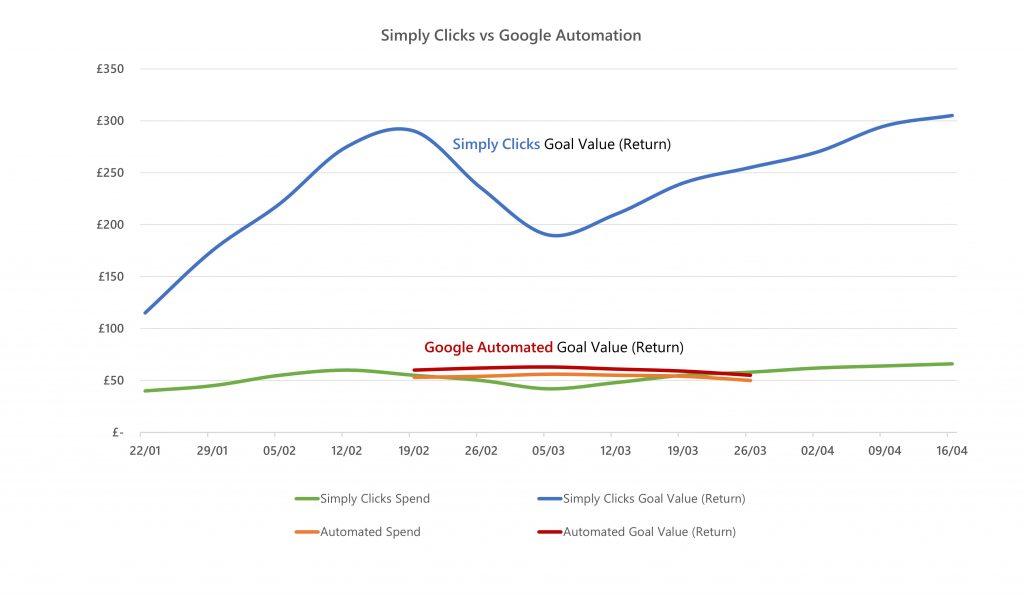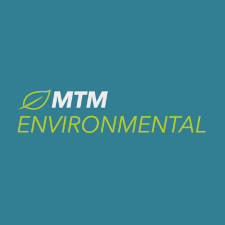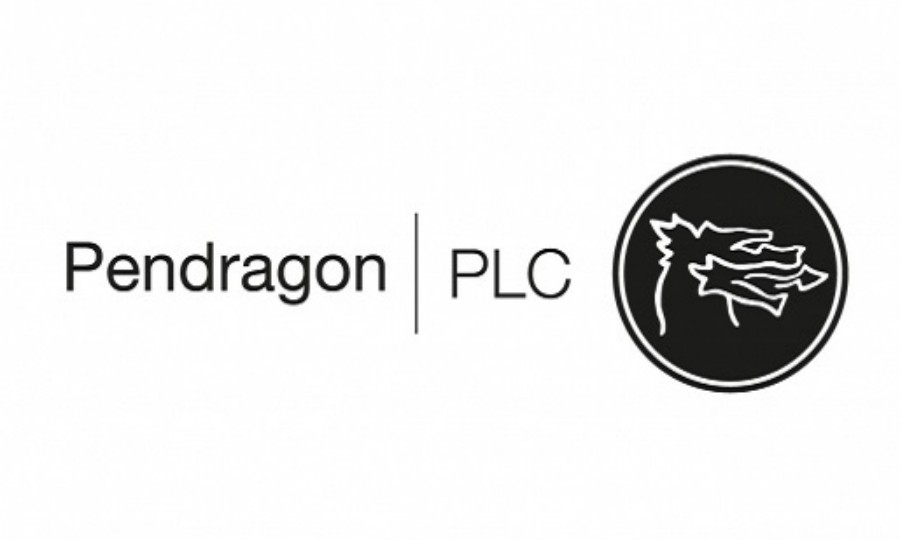SEO and PPC for Luxury Leisure Supplier
MTM Environmental
Venue Holidays
Automated PPC vs Manual Expertise
TLDR;
We recently had the opportunity to run a PPC campaign against Google’s smart bidding. After 6 weeks, the results show why you should continue using a Digital Marketing agency, like Simply Clicks, to run your PPC Advertising.
Our Story
One of our clients was working on their Google My Business presence. Whilst doing so they were contacted by a Google adviser and encouraged by them to set up an automated Google ads campaign. Between the client and the Google adviser they plugged in the necessary information to get the PPC campaign started, and off they went.
A few days later, we spotted via Google Analytics that the client’s PPC spend on the account was starting to increase above budget. So we investigated. We saw that an additional Google Campaign was live. We made contact with our client, who confirmed the details. Our response was to leave the campaign running. And so, the stage was set. Our “manual” PPC campaign was up against Google’s “automated” PPC campaign.
Calculating return on advertising spend (ROAS)
We measure a number of conversions on the account and apportion a nominal value against each of them. The client’s average revenue per sale is above £50,000, with a 30% plus margin. Enquiries, where full contact details are acquired, are valued at £50: downloads, phone calls and emails at various values between £5 and £20.
The Results
A couple of weeks in, it was clear to us that Google was bidding on terms that were unlikely to achieve the same return on ad spend (ROAS) as ours. But building a successful PPC campaign takes time. Maybe the intelligence behind the google engine needed more time and information. Therefore we decided to allow the automated campaign to continue for another few weeks.
After 6 weeks in, ROAS was not improving and we decided to switch off Google’s automated campaign. So what do the results look like?
The graph below shows the Spend Amount and the Goal Values for each campaign.
The good news is that, although Google’s automation didn’t perform as well as Simply Clicks’, it did generate a positive return. Just.

Result Insights
On average, the “automated” campaign delivered a £1.11 return for every £1 spent. Whereas, the Simply Clicks’ “manual” campaign generated £4.42 of nominal value for every £1 spent.
In the Simply Clicks campaign, the terms containing the clients brand name generate 6.5% of its nominal conversion value. And the average cost per click (CPC) is 8p. Meanwhile, in the “automated” campaign, the terms containing the clients brand name generate 18.1% of its nominal conversion value. And the average CPC was 19p.
One observation from previous experiments is that Google automated campaigns will tend to buy and overbid for branded terms. As these will more easily convert than generic search terms.
Concluding Remarks
Using a Digital Marketing agency clearly has its benefits. When we retrospectively looked at the results, we asked ourselves, why?
We obviously believe in our skills and our business. And the results back that up on their own. But Google’s automation has the challenge of doing right by all of its customers, including the customers that are competing with each other. If you have more than one business competing automatically through Google’s auction platform, how does it decide who should win?
We think the simple answer is that they all do. Which explains why the campaign we observed made a positive return. But not by much.
Bounce Rate and How to Improve it
Bounce rate refers to website traffic that enters a site and leaves without carrying out any sort of action. A higher than average bounce rate indicates that there is an issue with your website, web page or web traffic. It is therefore considered to be a negative measure of website performance.
This measure, however, doesn’t impact your search engine ranking factor, a key part of SEO. This is mainly due to the behaviour we humans have adopted over time. We move across the internet in a more erratic way causing more website interactions to be recorded as a “bounce”. For this reason, it is illogical for search engines to go against what is becoming natural human behaviour.
So this measure acts as more of an indicator to see if you website, web page or web traffic is having the effect that you originally intended.
Industry Measures
There a few definitive measure of average bounce rate performance. In the past, Google published a benchmarking report that reported that the average bounce rate was 42.5%. The report included details of average bounce rate by country, by visitor type and by device.
Google Publication: Predicting Bounce Rates in Sponsored Search Advertisements
A well established “How to” guide
The best guide we can find is Confluent Forms – Guide to the meaning of Bounce Rate in Analytics. It has stood the test of time, first published in 2015 and last updated in late 2019.
Our advice on improving this measure
Include simple and accessible links to related information on your website. Think like Wikipedia and mirror their easy site wide navigation. This can be as simple as linking keywords in your blog posts and grow to be as complex as dynamically updating viewable content based on the visitor.
How to Implement a 301 Redirect
Implementing a 301 redirect or more precisely managing 301 redirects is increasingly an integral part of technical SEO. This is especially the case when websites expand or migrate from one owner, host, domain or code platform. Over time, websites, if not properly managed, tend to get ragged. Duplicate content, broken links and out of date site maps tend to be errors that show up in your Google Search Console Tools or Moz crawl diagnostics summary. Firstly a 301 redirect redirects a browser from an old to a new location. Secondly, and most importantly for SEO, a 301 redirect tells search engines that your web page has been permanently moved to another location or address. As a consequence, the search engines transfer the PageRank, or link juice, from the old location to the new.
Using a CMS for your Redirect
If you utilise a content management system or CMS, there are quite often tools inside that allow you to arrange redirects. Check in your CMS tools section first. If you use WordPress or similar platform you may find a plug-in that will do the redirect. If not, you will have to arrange the redirect yourself, usually via a .htaccess file. In my case, I was working on two separate redirects. One to send http://simplyclicks.com traffic to www.simplyclicks.com. The other to eliminate the index.html versions of my home page. There are good reasons for undertaking both redirects.
Redirecting http://yoursite.com to http://www.yoursite.com
There are two good reasons for implementing this redirect. Firstly, Google may treat the http:// only and the www versions of your site as two different sets of documents. Secondly here is a risk that you will build up two sets of inbound links. There are many ways of organising a redirect and the way selected depends on your operating system and server. In the most recent case, I was organising a redirect on an Apache server utilising Linux.
Redirecting www.yoursite.com/index.html to www.yoursite.com
My main reason for organising this redirect is a problem I have with web analytics. Quite often, web analytics will treat these two versions of the home page as two different pages. So you end up adding and diving all the time to get consolidated statistics for your home page. The second reason is more long term and affects link building. What happens, if people send links to a home page which is www.yoursite.com/index.html and you moved platforms? So that your home page became www.yoursite.com/index.php? Without a redirect, the old page would become a broken link, losing all its link juice or PageRank. This redirect also applies to a redirect of .php or similar. But not .asp as this would be covered by the Microsoft IIS and is not covered here.
The 301 Redirect Code
Below, I show the code used for organising both redirects in the same .htaccess file. The redirects must be in this order. The .htaccess file is uploaded to the root directly of your website that contains your home page.
########
RewriteEngine On
#
# redirect index.htm and index.html to / (do this before non-www to www)
#
RewriteCond %{THE_REQUEST} ^[A-Z]{3,9}\ /.*index\.html?\ HTTP/
RewriteRule ^(.*)index\.html?$ http://www.yoursite.com/$1 [R=301,L]
#
# redirect domain.com -> www.domain.com
#
RewriteCond %{HTTP_HOST} ^yoursite\.com$ [NC]
RewriteRule ^(.*)$ http://www.yoursite.com/$1 [R=301,L]
########
If you use this code you will need to change the “yoursite.com” to your exact domain, e.g. simplyclicks.com in my case. This code works for me on Fasthosts.com, the largest UK hosting provider. You may need to make several tries and depending on your web host wait for the new .htaccess file to become activated.








